 Fantasy camps are hot. They started with "Dude Ranches," places where the city-born could ride the prairies with a broad Stetson on their noggins and a whiff of sweaty horse in their nostrils. From that simple Western beginning, fantasy camps have branched out into dozens of fields. You can now indulge your dreams of being a pro baseball, football, or basketball player. You can race cars, you can ride bulls, you can luge or play jazz or learn how to make a guitar. You can even play James Bond at a covert operations camp … or, if that sounds too strenuous, attend a three-day "Beer Camp" in Kentucky.
Fantasy camps are hot. They started with "Dude Ranches," places where the city-born could ride the prairies with a broad Stetson on their noggins and a whiff of sweaty horse in their nostrils. From that simple Western beginning, fantasy camps have branched out into dozens of fields. You can now indulge your dreams of being a pro baseball, football, or basketball player. You can race cars, you can ride bulls, you can luge or play jazz or learn how to make a guitar. You can even play James Bond at a covert operations camp … or, if that sounds too strenuous, attend a three-day "Beer Camp" in Kentucky.
 For pilots, there are a number of "fighter ace for a day" programs, using a variety of aircraft for simulated air combat. You can strap on an ex-military trainer and pretend you’re hunting Fokkers over the Somme, or MiGs over Iraq. But there’s a level of the pilot pyramid even above that of fighter jock: those who ride into space atop a flaming rocket. The fighter world can have their F-14s and their calls of "Fox Two." Some of us fondly remember Project Mercury and "We have liftoff … and the clock is operating!" And that’s where our own fantasies lie. We sit at our desks, we fly our Cessnas, we may even push airline iron from Tedium to Apathy and back. But every time a TV screen shows the Space Shuttle heading towards the Big Black, we stop. We watch. And in our heart of hearts, we curse our bad eyesight, we curse our high school math scores and we curse any of the myriad other reasons we didn’t make it into the astronaut corps.
For pilots, there are a number of "fighter ace for a day" programs, using a variety of aircraft for simulated air combat. You can strap on an ex-military trainer and pretend you’re hunting Fokkers over the Somme, or MiGs over Iraq. But there’s a level of the pilot pyramid even above that of fighter jock: those who ride into space atop a flaming rocket. The fighter world can have their F-14s and their calls of "Fox Two." Some of us fondly remember Project Mercury and "We have liftoff … and the clock is operating!" And that’s where our own fantasies lie. We sit at our desks, we fly our Cessnas, we may even push airline iron from Tedium to Apathy and back. But every time a TV screen shows the Space Shuttle heading towards the Big Black, we stop. We watch. And in our heart of hearts, we curse our bad eyesight, we curse our high school math scores and we curse any of the myriad other reasons we didn’t make it into the astronaut corps.
Well, buck up. It’s time to sign up for Space Camp and live the fantasy.
Living The Fantasy
It started for the pre-teen set. Space Camp, in Huntsville, Ala., began in 1982 as a weeklong activity for grade-schoolers. But within two years, the Space Camp folks had added Space Academy for the teenagers, and just a year after that, they brought through their first adult group. They’ve grown quite a bit over the years. They added programs for older teens, teachers, and corporations. The initial facility in Huntsville was soon augmented by a second site in Titusville, Fla. Space Camps popped up all over the world … in California, Canada, Japan, Belgium, and even Turkey.
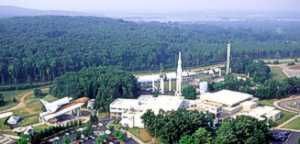 I hadn’t paid much attention to it, myself. After all, I’ve worked as a Space Systems Engineer for almost 25 years. The space hankerings of an old friend, Blake Ortner, burned hotter than my own. For years, Blake had talked about going to Advanced Space Academy for Adults. Then this year, he turned 40. His wife and father-in-law bought him a week at camp … and his ol’ buddy Ron decided to go with him.
I hadn’t paid much attention to it, myself. After all, I’ve worked as a Space Systems Engineer for almost 25 years. The space hankerings of an old friend, Blake Ortner, burned hotter than my own. For years, Blake had talked about going to Advanced Space Academy for Adults. Then this year, he turned 40. His wife and father-in-law bought him a week at camp … and his ol’ buddy Ron decided to go with him.
Arrival…
The Huntsville Space Camp operation is based at the U. S. Space and Rocket Center (USSRC), a museum located just outside NASA’s Marshall Space Flight Center. The center features a considerable array of space flight artifacts, including an outdoor "rocket park" with displays of vehicles ranging from the V-2 to the Saturn V to a full-size Space Shuttle, external tanks, solid boosters, and all.
When Blake and I boarded the bus for the short trip from the Huntsville airport to the Space Camp facility, we started to worry a bit. The only other people on the bus were in their twenties … barely. For a while, it looked like we might end up being the crotchety old-timers at the camp. Not to worry, though. We ended up being right around the average age of the attendees. There was gray hair aplenty, and some that wasn’t gray looked suspiciously bottle-generated. Professions varied widely … from an Australian nanny to a Washington lobbyist; from an Ohio lawyer to, well, a Seattle aerospace engineer. About 50 people had enrolled for our one-week session; about a third were women.
…Accommodations…
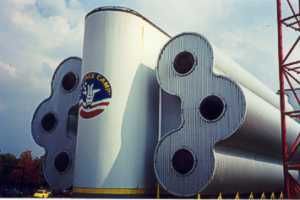 One of the questions I had was how well the camp adjusts to having adults, instead of kids. Would we be confined to our quarters when not in training, or handed demerits for minor infractions? Part of it, I suppose, was guilt … after all, I hadn’t sewed nametags inside my clothing like the "Camper’s Checklist" said. The camp quickly put those fears to rest. We were issued badges that would allow us to exit and enter the site at any time of the day or night, and they otherwise made it clear that we weren’t to be as closely controlled as the kids. Our first evening at camp included viewing a feature film in the IMAX theater with a wine-and-cheese intermission. We didn’t have "reveille" like the kids did, just a counselor coming by right before breakfast to make sure no one had overslept.
One of the questions I had was how well the camp adjusts to having adults, instead of kids. Would we be confined to our quarters when not in training, or handed demerits for minor infractions? Part of it, I suppose, was guilt … after all, I hadn’t sewed nametags inside my clothing like the "Camper’s Checklist" said. The camp quickly put those fears to rest. We were issued badges that would allow us to exit and enter the site at any time of the day or night, and they otherwise made it clear that we weren’t to be as closely controlled as the kids. Our first evening at camp included viewing a feature film in the IMAX theater with a wine-and-cheese intermission. We didn’t have "reveille" like the kids did, just a counselor coming by right before breakfast to make sure no one had overslept.
The $899 fee for the weeklong Advanced Space Academy includes the loan of a NASA-style flight suit, meals, and housing. The meals were cafeteria-style, with a selection of entrees. Housing was in the main dormitory, in seven-person rooms with bunk beds and lockers. The space-age architecture of the dorms probably appeals to the kids, but my aged (and heavy) bones rebelled somewhat against the long climb to the upper bunk and the thin mattress that awaited me. While there were soft-drink and candy machines in the dorm, the closest coffee was a few hundred yards away in another building … rather hard for those with a caffeine jones at 6:30 a.m. Adult campers who prefer private rooms with a few more amenities might be advised to make reservations at the Marriott that shares the USSRC parking lot.
Other buildings on the USSRC grounds house other Space Camp facilities, such as the classrooms, environment simulators, and Martian mission facility. However, the main training floor, with its Shuttle Orbiter, Space Station, and Mission Control simulators, is located within the main museum building. This meant we often had a pack of gawking tourists watching us, but it also meant we could quickly stroll into the museum when we had free moments.
…Scheduling…
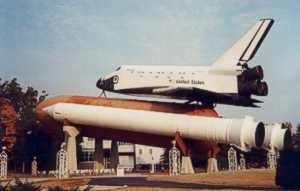 Not that we had that much free time, of course. Space Camp gives you your money’s worth, with training beginning immediately after breakfast and running until 10:00 or 11:00 at night. The camp curriculum tracks that of astronaut training … classroom sessions, practice with training aids, and short-duration simulations, leading up to a detailed six-hour Extended Duration Mission (EDM) on our last evening at camp. To someone familiar with conventional training programs, the scheduling seemed a bit chaotic. We were thrown into the simulations, in fact, before we’d received one bit o’ book learnin’ on the systems themselves.
Not that we had that much free time, of course. Space Camp gives you your money’s worth, with training beginning immediately after breakfast and running until 10:00 or 11:00 at night. The camp curriculum tracks that of astronaut training … classroom sessions, practice with training aids, and short-duration simulations, leading up to a detailed six-hour Extended Duration Mission (EDM) on our last evening at camp. To someone familiar with conventional training programs, the scheduling seemed a bit chaotic. We were thrown into the simulations, in fact, before we’d received one bit o’ book learnin’ on the systems themselves.
Not that we minded. The training floor included four … count them, four … full-sized replicas of the Shuttle Orbiter forward section, including the flight deck and the mid-deck. I think they would have had a mutiny if we hadn’t been scheduled to use the simulators the first day at camp. Ultimately, though, the scheduling scheme made sense. The classroom material was easier to take when it was split up a bit (remember, this is supposed to be fun), and it let the Space Camp planners use the facilities more efficiently.
…Classroom Work…
Working in aerospace as long as I have, I expected to find the classroom work a touch tedious, and was curious about how good the "amateur" instructors were. I was surprised by how much I enjoyed the courses. It was a joy seeing, for instance, how the Orbiter systems were laid out similarly to the unmanned spacecraft I’d been working on. And there were several topics, such as astronomy, that I hadn’t considered for years. I felt a childlike delight in standing on the nighttime grounds behind a telescope and looking at the rings of Saturn for the very first time.
The speakers were bright, knowledgeable, and presented the material well. Most were college students working part-time at the Camp, yet they were able to go surprisingly deep into the material to answer questions. I kept my ears open, but wasn’t able to "catch" any of the instructors in an error in basic space physics. When they didn’t know the answer, they didn’t try to bluff it out. They’d do off-hour research to find the information for us.
Practical Experience
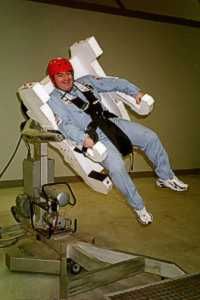 NASA spends millions of dollars to develop high-tech training aids to prepare its astronauts for space. Space Camp doesn’t have that kind of budget. Instead, the program has designed and built simplified trainers that provide much of the same experience without the need for congressional funding or a standing army of repair technicians.
NASA spends millions of dollars to develop high-tech training aids to prepare its astronauts for space. Space Camp doesn’t have that kind of budget. Instead, the program has designed and built simplified trainers that provide much of the same experience without the need for congressional funding or a standing army of repair technicians.
Take simulating the Manned Maneuvering Units (MMUs), the little propulsion units that allow Shuttle astronauts to fly freely through space. Space Camp’s MMU simulators float on air bearings. Trainees skitter across the floor, controlling yaw, roll, and translation through hand controllers. True, there’s no vertical motion … but the system doesn’t require a computer-controlled crane and multiple safety systems. Similarly, the 1/6th-G simulation consisted of a traveling crane, some stout bungee cords, and a J-shaped seat. It wasn’t as high fidelity as a NASA simulator might be, but it let trainees do a "moon-walk" that was quite similar to the old Apollo films.
The Underwater Astronaut Trainer (UAT) came fairly close to replicating the experience in NASA’s neutral buoyancy tanks. "There are two ways to simulate weightlessness on Earth," said the instructor. "And this way is the most comfortable." After basic SCUBA instruction, we dropped to the bottom of Space Camp’s 24-foot-deep water tank. A shuttle orbiter pallet nestled there, with a simulated satellite attached. We swapped "batteries" on the satellite, replaced hoses, and removed and re-installed an antenna.
Mission Training…
Upon enrollment, we’d signed up for one of three mission areas: payload specialist, mission specialist, or pilot. For mission training, our 18-person team split into three groups, one for the Shuttle Orbiter, the Space Station, and the Mission Operations Control Room (MOCR). We rotated assignments for each session of training. In the MOCR, we acted as ground controllers for both the Orbiter and Space Station missions. Multiple tiers of computer workstations were ranged in front of large displays in front. Data was presented on the computers, and the Orbiter and Space Station crew would report anomalies that we would attempt to diagnose.
The Space Station included two main modules and one of the interconnecting nodes. The modules are boxcar-shaped, with lockers and equipment lining the walls inside. There, we performed experiments and handled basic station maintenance duties.
…Pilots, Man Your Orbiters
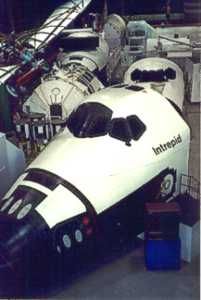 For the pilots, of course, the real attraction was the Shuttle orbiter simulators. The orbiters at Space Camp are named after actual or proposed vehicles; the Adult Space Academy uses "Enterprise." The Camp orbiters provide varying levels of fidelity to the actual vehicle. Some provide only the cockpit areas; others, like Enterprise and the newest, Intrepid, include the aft crew station and side consoles as well.
For the pilots, of course, the real attraction was the Shuttle orbiter simulators. The orbiters at Space Camp are named after actual or proposed vehicles; the Adult Space Academy uses "Enterprise." The Camp orbiters provide varying levels of fidelity to the actual vehicle. Some provide only the cockpit areas; others, like Enterprise and the newest, Intrepid, include the aft crew station and side consoles as well.
Enterprise is a full-fuselage mockup, with the forward cabin with both the mid and upper decks, a payload bay with a Spacelab module installed, and the aft fuselage with the Orbital Maneuvering System (OMS) pods and a shortened vertical stabilizer. Enterprise’s payload bay is also truncated; it’s 15 feet shorter than the actual. The round side hatch provides entry to the middeck, which is the main living quarters. A narrow ladder provides access to the flight deck above.
On the flight deck, the commander sits in the left seat and the pilot in the right. Both are surrounded by an incredible array of controls. Switches are grouped on numbered panels; over 25 panels are accessible to the seated commander or pilot, each with 10 to 50 controls or indicators on them. And your job, Mr. or Ms. Pilot or Commander, is to learn their locations well enough after two one-hour practice missions to be able to keep up with the countdown.
One thing one doesn’t do on Enterprise, sadly, is actually "fly" a simulator. Enterprise is a procedures trainer; the joysticks aren’t actually connected to anything. The flight instruments are just blueprints on the forward panels, and the video monitors installed in the forward windows just run a videotape taken from orbit. The disappointment quickly passed. There was certainly enough to keep the pilot and commander busy, and "following through" on the joystick during approach and flare to Edwards (while continuing to execute the final checklist) was good substitute. Besides, who wants to "crash" the simulator at the end of a six-hour mission and ruin the whole crew’s fun?
Graduation Exercise
The week’s training led up to the Extended Duration Mission. Our mission would be to launch the Shuttle, rendezvous with the Space Station, and return to Earth.
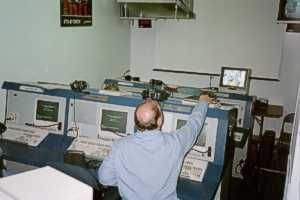 The immediate problem was crew assignments. The folks in the pilot track, of course, wanted to be in the orbiter instead of the station or the MOCR. The decision was made to swap orbiter crews after Space Station docking, so now we had three commanders and three pilots competing for four cockpit positions. One commander decided he’d like to work as CAPCOM in the MOCR, and his pilot agreed to take the flight director spot.
The immediate problem was crew assignments. The folks in the pilot track, of course, wanted to be in the orbiter instead of the station or the MOCR. The decision was made to swap orbiter crews after Space Station docking, so now we had three commanders and three pilots competing for four cockpit positions. One commander decided he’d like to work as CAPCOM in the MOCR, and his pilot agreed to take the flight director spot.
My friend Blake and I were the remaining commanders. We agreed that my crew would take ascent, as my pilot and I had actually beaten the "par" times for executing some of the pre-launch checklists. Blake and his pilot would work the flight officer position on the Station. We’d swap over after rendezvous, and Blake’s crew would handle re-entry and landing. Counselors (known as "Ghosts") would join us at the stations, both to initiate emergency situations as required and, we were warned, to "float" any object not secured while in orbit.
We boarded the shuttle, stowed our gear in the lockers, and took our stations. We could monitor countdown and systems status on small CRTs in the forward panel, and a central CRT showed an external camera view of the launch stack. It was a night launch; stars shone in the forward windows. We checked communications with CAPCOM, and settled down to the pre-launch sequences.
The countdown started at T-9 minutes, vs. the T-5 my pilot and I were used to. We had to execute some new checklists, which meant some time wasted scanning to find the new switches. Then we reached the T-5 minute point, and our previous training took over. We quickly made up the 30 seconds or so we were behind.
At T-minus 30 seconds, control of the launch was turned over to the onboard computers. At T-minus six seconds, a rumble filled the cockpit as the main engines started. The pilot and I slid our throttles to 100 percent in case the computer erred.
The timer hit zero. The rumble increased. The exterior monitor flashed as the solid boosters ignited, and stars seemed to tremble as the Shuttle slid skywards.
"Houston, Enterprise, we have liftoff," I called over the headset. Then, inaccurate or not, I added, "And the clock is running!"
Derring-do in Orbit…
I kept my eyes on the main engine status lights during ascent. In our training missions, we always lost an engine, and would then have to perform one of the abort options. This time, the engines burned strong and steady. At T-plus 50 seconds, we throttled down to minimize aerodynamic pressure, then throttled up once Max-Q was passed. The solid rockets burned out and separated at about T-plus 2 minutes. We pitched over to horizontal. Continents and clouds moved past the windows.
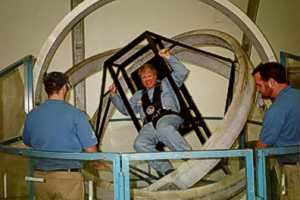 At T-plus eight minutes and 40 seconds, the main engines finished their burn. I had just moved the Translational Hand Controller upward to move the orbiter away from the just-separated External Tank … when my pilot clutched his stomach, screamed in simulated agony and collapsed dramatically across the center console.
At T-plus eight minutes and 40 seconds, the main engines finished their burn. I had just moved the Translational Hand Controller upward to move the orbiter away from the just-separated External Tank … when my pilot clutched his stomach, screamed in simulated agony and collapsed dramatically across the center console.
The "Ghosts" had struck!
After a moment’s stunned surprise, I told two other crew members to "float" the unconscious pilot out of his seat, and ordered one of the mission specialists to take over as pilot. Though she’d never worked the position before, we managed to get the payload doors open and the radiators working, and to program the onboard computer to fire the OMS engines to enter the rendezvous orbit. My pilot returned, miraculously cured, to be greeted by an avionics bay overheat warning light. I had waited years to be able to say it. I slid the headset mic slightly closer to my lips: "Houston, we have a problem."
No answer. Unbeknownst to us, the "Ghosts" had struck at Mission Control, as well. One controller was down with an epileptic seizure, and the several others had been "electrocuted" when water had dripped onto their consoles during a hurricane.
The Space Station was having its problems as well. The crew were lifting panels, trying to locate an air leak. One crewmember was struck by a piece of ("Ghost"-supported) loose gear, and red blobs marked "blood" were floating through the cabin.
On Enterprise, an obnoxious red light and buzzer continued to announce there was an overheating avionics bay, and now the payload and mission specialists on the middeck were scrambling, trying to locate the source of a smoldering fire. One found the fire by the simple expedient of lifting a piece of paper from under a chair (it said, "Fire") and ended up being treated for third-degree burns on his hands.
Still, we did it. Mission Control came back on line. The mission specialists, one supported on the remote arm and the other on a "Superman" rig to haul herself around the payload bay, fixed a balky spacecraft and released it into orbit. Three hours into the mission, the space station appeared in our forward windows. We secured our positions as the orbiter docked, and swapped positions with the Space Station crew.
A different set of problems faced us aboard the station, while the new orbiter crew faced a different set of anomalies and a fresh batch of crises flared up in the MOCR. Eventually, we were forced to abandon the Space Station, performing an "EVA" back to the orbiter for re-entry and landing. I sat in the rear of the flight deck and watched Blake and his pilot perform the descent. Cape Canaveral appeared in the windows. The pilot deployed the landing gear and Blake came back on the stick as the threshold passed below the orbiter’s nose. Touchdown, speed brakes open, and finally, "Nosewheel steering to off" to complete the final checklist item.
…Mission Accomplished
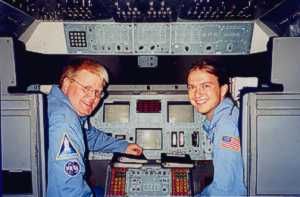 Afterwards, we rehashed the mission over drinks at a nearby bar. We laughed at the "medical" emergencies, we told tales of solar flares in the Space Station and water leaks in the MOCR. Blake and I dissected our stints as commander. We handled the emergencies well enough, we’d thought, though we’d both made the same error while programming one of the orbiter OMS burns. The adrenaline was still flowing, and we were still psyched up.
Afterwards, we rehashed the mission over drinks at a nearby bar. We laughed at the "medical" emergencies, we told tales of solar flares in the Space Station and water leaks in the MOCR. Blake and I dissected our stints as commander. We handled the emergencies well enough, we’d thought, though we’d both made the same error while programming one of the orbiter OMS burns. The adrenaline was still flowing, and we were still psyched up.
The next day, we toured the Marshall Space Flight Center, then caught the bus for the airport. On the Monday after our return home, Blake called, laughing. He’d been listening to the NASA channel as the orbiter Discovery prepared to re-enter after its space-station assembly mission. He’d overheard the pilot and commander executing their checklists … and they were identical to the ones he’d performed on the long mission.
A different moment from the EDM sticks in my mind. We were about two hours into the mission, working on one of the innumerable system anomalies. I was hunched down, trying to find one of the switches on the center console. "Looks like the Red Sea," said my pilot. I glanced up, and sure enough, there was the Sinai peninsula sliding majestically past the cockpit windows.
A double knock from behind caught my attention. The aft flight deck windows showed two grinning Mission Specialists, wearing their "space helmets," waving to us prior to starting their satellite repair.
Sure, we were actually ramrodding ground-bound boxes of plywood and plastic. The "satellite" suspended over the Orbiter bay started life as a septic tank (with a lot of cosmetic enhancement added, since). But I was sitting in the commander’s seat on the flight deck of the Space Shuttle, in my blue NASA flight suit, the Earth was flowing smoothly by the cockpit windows, and my crew was hard at work on a difficult mission. It seemed almost real.
And after all … wasn’t that the point?
Recommendations
While there are three Space Camp facilities in the U.S., only the Alabama location offers the Adult camp. A weekend program is also available, though it doesn’t include some elements, such as the underwater training. The programs do tend to book up early … we made reservations six months in advance, and had trouble getting the dates we wanted. If you go with a friend, register together so you end up on the same team.
The program involves some bending and crawling through hatches and tunnels, and climbing short ladders. This isn’t continuous, though, and shouldn’t be an impact unless one has definite mobility problems. Attendees are required to be at least 19 years old for the adult programs, with no upper age limit … they’ve had octogenarians through the program, performing everything including the neutral buoyancy tank.
Taxi service is available from the airport in Huntsville, or one can sign up (in advance) for the Space Camp bus. With the training day running until 10:00 p.m. or so every evening, there’s really no need for a rental car. The Marriott (assuming you wish to forgo dorm life) is in easy walking distance. You are issued a flight suit for your time at camp, so you won’t need extensive changes of clothes. No laundry facilities are available. Bring a camera, but I recommend a small compact model rather than a bulky SLR.
For further information, check the Space Camp web site.


































